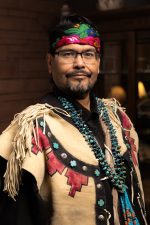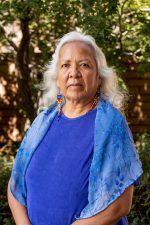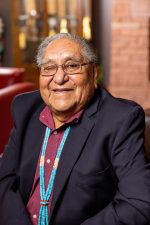Elder Q&A
CNAIF Elders Program
The Elder Program is new to the Center for Native American and Indigenous Futures (CNAIF). However, this program was previously housed in the Applied Indigenous Studies Department until Fall 2016 and was known as the Traditional Knowledge Scholar program. This program has been an essential component to support NAU’s mission to serve Native American students and increase retention efforts. Placing Elder Cultural Advisors in one-on-one contact with students maintains cultural continuity, offers traditional knowledge teachings on campus and in the community about lifeways and indigenous philosophies, and balances Native cultural traditions with university life. The Elders do not hold faculty positions and are funded through private gifts and grants.
The Elders are centered on meeting and mentoring students, and by helping them find solutions to individual problems by offering cultural and spiritual support. Other areas that the Elder Cultural Advisors assist with include giving presentations to NAU staff, faculty and students in a variety of formats and assisting students with off-campus referrals for spiritual and cultural needs and contributing to recruitment and retention efforts.
The Elders are in the Center for Native American and Indigenous Futures (CNAIF). Elders are involved in outreach, research, and other activities with the local Flagstaff and neighboring tribal communities. The Elders provide a lecture series every semester, check the CNAIF Events page for the dates of the Learning from Our Elders Lecture Series.
AY 2023 – 2024 CNAIF Elders
Elder Viki Blackgoat
Ya’at’eeh, shí ei Viki Blackgoat daashijiníí. Todichinii nishłiigo Tliziłani bashishchiin. Ashihi dashicheii dó Tsenijikinii dashinali. Dii ko’tego Diné asdzaan nishłii.
I was raised on Black Mesa in an area known as Big Mountain (Dził ni’tsa). Within my immediate birth family unit I am the youngest of six children, sister to three surviving siblings, mother to three children, aunt to fifteen nieces/nephews, and a grandmother to three grandchildren; and a “small” grandma to about twenty-six grandnieces/grandnephews, AND great-aunt to three.
My primary interests include advocating for youth, elders and education, and holding strong traditional values and language, being a responsible relation within K’é, and being a thoughtful steward for our natural world, the Earth. I currently serve as a board member of the Indigenous Circle of Flagstaff (ICF).
Read more: CNAIF Elder Viki Blackgoat
Elder LeRoy Shingoitewa
Hopi Tribe member/Bear Clan. Born in Keams Canyon, AZ
Family: Mavis-Spouse Children: Curtis Honanie, Eugene Honanie. Le Roy J. Shingoitewa, Michelle Shingoitewa, Kimberly Tom
Home Residence: Moenkopi Village on the Hopi Reservation.
Education: Northern Arizona University: 1969 BS-Sociology/Police Science; 1972 Pennsylvania State University: Med-Educational Leadership; 1975-1979 Pennsylvania State University-Doctorial Studies in Educational Leadership
Experience: 25 years in Educational Leadership; 25 years in Tribal/Organizational Management. Former Hopi Tribal Chairman 2009-2013; Hopi Tribal Councilman 2015-2019. Principal of Tuba City High School/Tuba City USD 1994-1999. Principal of Lura Kinsey Elementary School/Flagstaff Unified School District 1999-2007. Only Native American who has served as Principal in the City of Flagstaff Schools. Served on Public School Board, BIE School Boards and 100-297 Tribal School Boards. Served as President and Board of Director Member on the Native American for Community Action 2000-2005. Was Awarded the “676 Point of Lights Award” by President George Bush in 1992 for Volunteerism.
Read more: CNAIF Elder LeRoy Shingoitewa
Elder Albert Chase

My Clans are:
Honághaanii nishłį́, One Who Walks Around in today’s translation, but according to my grandmother, Honághanii nishłį́, is from the shoulder people, as stories tell we were made from shoulder of Changing Woman.
México Dine’é báshíshchíín, People of Mexico, or people of the south. (Possibly the Aztecan people)
Txóbąąhí dashicheii, Edge Water are my maternal grandfathers.
Naatxoohí Diné’é dashinálí – Isleta Pueblo are my paternal grandfathers.
My original place of home is where my hoghan nímazí exists.
The place where my young mind developed and recognized as my first home and first language is called Dibénjígą́ą́h-Big Horn Sheep Mountain or Łį̨́į́’ Hádét’į̨įh- Looking Horse. That is my original place and land that I come from. This is where I recognize sitting on dirt floors and eating with family, my elders and great-grandparents. This place is where I experienced the soft and warm beddings of sheep hide and the warmth of woven blankets. This place is where I heard the crackling of our fire pit in the center of our dwelling and saw the cloud of smoke rising to the sky through the smoke hole. This place is where I can hear grandmother carding her wool and spinning her wool while waiting for the coffee and food to finish. This place is where I could hear grandfather releasing the sheep for the day and hear the morning greetings of the flock and the ringing of their bell necklaces. This special place is embedded in me and is the driving sentimental force and blessings, which must be shared with our coming generations.
Read more: CNAIF Elder Albert Chase

